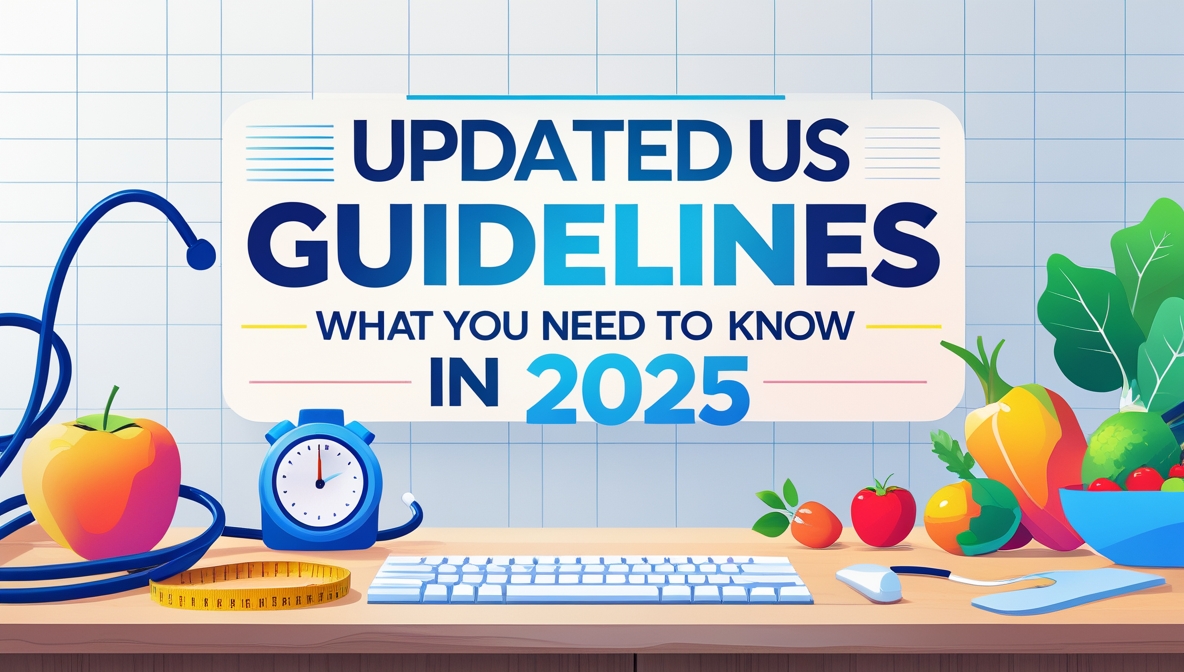Updated US Guidelines for Obesity: What You Need to Know in 2025

Obesity is a growing health crisis in the US, impacting millions and increasing the risk of serious diseases. The updated US guidelines for obesity aim to provide clear, science-backed recommendations to address this issue. These guidelines focus on prevention, treatment, and long-term weight management strategies. Understanding these updates is crucial for individuals, healthcare providers, and policymakers looking to tackle one of the nation’s biggest public health challenges.
Understanding Obesity: Definitions and Statistics
The term “obesity” is commonly used when discussing health risks, but what exactly does it mean, and how widespread is the problem in the United States? Understanding the definitions and trends can clarify why updated US guidelines for obesity have become an urgent focus.
Definitions of Obesity
Obesity is typically identified using Body Mass Index (BMI), a calculation based on a person’s height and weight. While it’s not the only measure of body fat, it’s widely used because it’s simple and consistent. Here’s how BMI classifications work for adults:
- Underweight: BMI less than 18.5
- Healthy Weight: BMI between 18.5 and 24.9
- Overweight: BMI between 25 and 29.9
- Obesity: Divided into 3 classes:
- Class 1 (Low risk): BMI 30.0–34.9
- Class 2 (Moderate risk): BMI 35.0–39.9
- Class 3 (High risk): BMI 40.0+
The classifications help healthcare professionals assess obesity-related health risks, such as Type 2 diabetes, heart disease, and certain cancers. Notably, BMI is a screening tool, not a diagnostic one, meaning other health factors are always considered. For more on the BMI system, check out the CDC’s guidance on BMI categories.
It’s also critical to note that BMI thresholds differ for children and adolescents. In these cases, obesity is defined relative to age and sex percentiles on growth charts. This adjustment accounts for the natural growth variations in younger populations, making measurements more accurate.
Current Obesity Statistics in the US
The obesity epidemic in the US has grown significantly in the past decades, and recent statistics paint a concerning picture:
- 42% of US adults were reported as obese in 2023, nearly double the rate from the 1990s.
- Severe obesity, defined as a BMI of 40 or higher, impacted approximately 9% of adults, according to the CDC’s latest data.
- Among children and teens (ages 2–19), one in five has obesity, highlighting the rising challenges for younger generations.
The prevalence of obesity also varies significantly across demographic groups:
- Certain ethnicities, including Black (49.9%) and Hispanic (45.6%) Americans, experience higher rates compared to White (41%) and Asian (16%) populations.
- Socioeconomic factors play a role, as lower-income families often have more limited access to healthy food and fitness resources.
- Regionally, southern states tend to show the highest obesity rates, largely driven by lifestyle and dietary patterns.
These trends are unlikely to slow down, with researchers projecting that by 2025, 36% of Americans may have obesity and 7.6% could be severely obese. These alarming forecasts emphasize the importance of updating strategies to meet this public health threat. For more insights into obesity trends, explore the World Obesity Federation’s recent analysis.
As the numbers climb, so do the healthcare costs and social challenges associated with obesity. This growing crisis is why the updated US guidelines for obesity adopt a proactive and science-driven approach to prevention, treatment, and management. Understanding these definitions and statistics underscores why action is non-negotiable.
The Importance of the US Guidelines for Obesity
Obesity continues to pose significant challenges for individuals, communities, and the healthcare system in the United States. The US guidelines for obesity aren’t just about numbers on a scale—they’re a critical roadmap aimed at reducing the widespread health and economic consequences of obesity. By setting evidence-based recommendations, these guidelines equip healthcare providers, policymakers, and individuals with the tools needed to combat this growing crisis effectively.
Public Health Impact
Obesity goes beyond appearance—it directly affects overall health, quality of life, and life expectancy. Carrying excess weight increases the risk of chronic diseases, such as:
- Type 2 Diabetes: High blood sugar levels caused by insulin resistance.
- Cardiovascular Diseases: Heart conditions linked to high cholesterol and artery blockages.
- Hypertension: Persistently high blood pressure adds strain to the heart and arteries.
- Certain Cancers: Increased risk of cancers, such as breast, colorectal, and liver.
- Sleep Apnea: Unnecessary fat around the neck can block airways during sleep.
In addition to personal health impacts, the economic burden is staggering. A report by the Centers for Disease Control and Prevention (CDC) estimates the annual healthcare costs related to obesity reach $173 billion. Individuals with obesity face an average of $1,429 more in medical expenses than those with a healthy weight.
From a societal perspective, obesity affects workplace productivity and national economic performance. Absenteeism, disability claims, and early mortality linked to obesity amplify its toll beyond healthcare costs. Addressing obesity at its roots through well-articulated guidelines ensures a healthier population and eases financial strain on individuals and the healthcare system.

Photo by cottonbro studio
Guidelines Development Process
Developing the US guidelines for obesity is a rigorous, collaborative process involving multiple stakeholders. These groups work together to ensure that recommendations are grounded in the latest scientific evidence:
- Expert Panels: Comprised of researchers, healthcare professionals, and behavioral scientists, tasked with reviewing the latest obesity-related studies.
- Public and Stakeholder Input: Government agencies like the Department of Health and Human Services (HHS) open surveys or focus groups to gather opinions from healthcare professionals and citizens.
- Adaptation of Emerging Research: Guidelines undergo revisions over time to incorporate advancements in medical understanding and treatments, including tools like pharmacotherapy and behavioral therapies.
- Peer Review: Before release, expert findings are scrutinized by an external panel to ensure objectivity, applicability, and accuracy.
For example, the VA/DoD Clinical Practice Guidelines update in 2020 underwent key steps like identifying pressing questions and prioritizing actionable strategies to address obesity in their scope.
This process ensures that guidelines remain dynamic and reflect a wide array of input, making them highly reliable and applicable to real-world scenarios.
By grounding strategies in a meticulous development process, the US guidelines for obesity promote a standardized, comprehensive approach to tackling obesity for Americans at every level—individual, community, and policy.
Overview of Current US Guidelines for Obesity
The current US guidelines for obesity provide a comprehensive framework designed to address the ongoing obesity epidemic. These are built on evidence-based strategies that encompass dietary habits, physical activity, and behavioral changes, offering actionable steps for individuals and healthcare providers.
Dietary Recommendations
The cornerstone of the obesity guidelines is promoting healthy eating patterns to support weight management and prevent related health complications. Recommendations emphasize nutrient-dense, minimally processed foods that foster a balanced diet. Here are the key principles:
- Focus on Whole Foods: The guidelines stress incorporating fruits, vegetables, lean proteins, and whole grains into daily meals. For example, instead of white bread, opt for whole-grain bread to increase fiber intake.
- Limit Added Sugars and Saturated Fats: Americans are encouraged to consume less than 10% of their daily calories from both added sugars and saturated fats. High-sugar beverages like sodas and snacks like fried chips should be replaced with healthier options, such as sparkling water and baked alternatives.
- Portion Control: A major emphasis is on managing portion sizes to prevent overeating. Engaging tools, like using smaller plates or pre-measuring portions, can help implement this practice in everyday life.
- Calorie Balance: Ensure caloric intake aligns with activity levels to prevent an energy surplus that leads to fat accumulation.
For detailed insights, consult the Dietary Guidelines for Americans.
Physical Activity Recommendations
Increasing physical activity is equally critical in combating obesity. The guidelines recommend a combination of moderate and vigorous exercises to improve health outcomes and aid in weight management. Here’s a breakdown:
- Weekly Exercise Goals: Adults are advised to achieve at least 150–300 minutes of moderate-intensity aerobic activity, such as brisk walking, or 75–150 minutes of vigorous exercise, such as running, per week.
- Muscle-Strengthening Activities: Include activities like weightlifting, yoga, or resistance exercises at least two days a week to enhance overall strength and metabolism.
- Children’s Activity: Kids and teens should have at least 60 minutes of physical activity daily, focusing on aerobic, muscle-strengthening, and bone-strengthening exercises.
These recommendations aim to not only address obesity but also reduce risks associated with chronic diseases. Learn more from the Physical Activity Guidelines for Americans.
Behavioral Strategies
Long-term success in tackling obesity often requires behavioral change and psychological support. The guidelines advocate for interventions that address the emotional and habitual aspects of eating and activity. Key strategies include:
- Self-Monitoring: Keeping a food and exercise diary is a proven method to stay accountable and identify patterns that might need adjustment.
- Goal Setting: Setting specific, measurable goals—like losing 5% of body weight or walking 10,000 steps daily—helps maintain focus and motivation.
- Behavioral Therapy: For individuals needing additional support, programs involving cognitive behavioral therapy (CBT) can help address emotional eating triggers and stress management.
- Education and Support Groups: Participating in structured weight management programs or peer-led support groups can provide the encouragement and skills necessary to sustain progress.
Explore more evidence and approaches in behavioral management through the CDC’s obesity strategies.
These strategies, combined with dietary and physical activity recommendations, create a robust, multi-faceted approach to addressing obesity in the United States.
Key Takeaways from the US Guidelines for Obesity
Understanding how to tackle obesity starts with actionable recommendations. The updated US guidelines for obesity highlight evidence-based strategies to improve weight management and reduce health risks. Below, we break down the most important steps individuals can implement to navigate this challenging health issue.
Summary of Recommendations
The guidelines provide practical and clear advice to support individuals in managing obesity effectively. Here’s a closer look at their primary recommendations:
- Prioritize Annual Screenings: Routine check-ups are critical. Healthcare providers emphasize annual obesity screening with tools like BMI measurements to identify risks early. This preventative approach helps catch weight-related health concerns before they escalate. Learn more about screening methods and their effectiveness.
- Adopt a Nutrient-Dense Diet: Focus on consuming whole, unprocessed foods—like fruits, vegetables, lean proteins, and whole grains. Limiting calorie-dense, sugary, and high-fat foods is essential for sustainable weight loss. For a deeper dive into healthy eating plans, read this comprehensive overview on dietary approaches.
- Commit to Regular Physical Activity: The guidelines emphasize the importance of exercise as part of overall weight management. Adults should aim for at least 150 minutes of moderate aerobic activity weekly, alongside two days of strength training. Establishing a routine doesn’t have to be daunting—simple actions like brisk walking or cycling make a huge difference. Explore more about the effectiveness of exercise-based interventions here.
- Incorporate Behavioral Health Support: Weight management extends beyond food and activity. Behavioral modification tools, such as cognitive therapy, self-monitoring through apps or journals, and goal-setting, can reinforce healthier habits. The role of emotional and mental wellness in combating obesity is increasingly recognized in the updated guidelines. For support options, check strategies recommended by the CDC on behavioral tools.
- Consider Pharmacotherapy When Necessary: In cases where lifestyle changes aren’t sufficient, medication may help. For those with a BMI of 30+ or significant obesity-related conditions, the use of pharmacological treatments is encouraged alongside diet and exercise. Learn about pharmacotherapy in the context of obesity interventions from the AGA Clinical Practice Guideline.
These recommendations provide a roadmap not only for those diagnosed with obesity but also for anyone looking to maintain a healthy lifestyle. By focusing on consistent action steps, the guidelines aim to empower individuals to achieve and sustain long-term results.
Resources and Support for Managing Obesity
Navigating the journey of managing obesity can feel overwhelming. Luckily, there are numerous programs and experts who offer valuable assistance. Whether through government initiatives or professional guidance, these resources can help pave the way toward better weight management.
Government and Community Resources

Photo by Julia Larson
Government organizations play a significant role in supporting individuals and communities affected by obesity. By providing programs and funding, they make resources more accessible for those in need.
- High Obesity Program (HOP): The CDC’s HOP initiative funds universities to work in areas with over 40% adult obesity rates, focusing on promoting healthier lifestyles through education and outreach.
- Medicaid and CHIP Initiatives: Programs like Reducing Obesity through Medicaid make healthcare access easier, addressing obesity through improved treatment options and preventive measures.
- Family Healthy Weight Programs: For family-based approaches to weight issues, the CDC offers resources such as recognized family programs, which emphasize physical activity, nutrition, and behavioral changes.
- MOVE! Weight Management for Veterans: Veterans can access VA programs like MOVE! to receive personalized weight management and lifestyle coaching. This free resource helps participants meet health goals with tailored guidance.
Additionally, many local governments partner with nonprofit organizations to organize community wellness programs. These initiatives often focus on increasing access to affordable nutritious food and safe spaces for physical activities, tackling obesity’s roots beyond healthcare.
Professional Guidance
Seeking professional help can be a game-changer for effective and sustainable obesity management. Specialists provide tailored advice that considers individual health histories, goals, and challenges.
- Dietitians and Nutritionists: A registered dietitian can help you navigate meal planning, portion control, and healthier eating habits. For evidence-backed strategies, explore the NIDDK’s guide on obesity treatment.
- Medical Professionals: Physicians specializing in obesity medicine work alongside experts like behavioral counselors to design multi-disciplinary plans. The Mayo Clinic’s obesity care approach highlights how medical interventions, including medications, can support weight loss.
- Behavioral Therapists: Tackling emotional eating or building new habits often requires addressing the psychological side of weight management. Working with a behavioral counselor can promote lasting change.
- Structured Weight-Loss Programs: Programs like Weight Watchers or other clinical providers use group settings to offer education and accountability. Discover more through expert-compiled tools like the Obesity Practice Guide.
Reaching out to professional resources might feel like a leap, but it provides the safety net and expertise necessary for long-term success. Whether engaging a therapist for emotional support or partnering with a healthcare provider, the combined knowledge ensures a more holistic approach to tackling obesity.
Conclusion
The updated US guidelines for obesity serve as a crucial framework to address a growing public health crisis. They emphasize prevention, comprehensive treatment, and sustainable weight management for individuals and communities alike.
By focusing on realistic dietary, physical activity, and behavioral strategies, these guidelines empower people to take actionable steps toward better health. Following them isn’t just about weight loss—it’s about reducing risks for chronic diseases and improving quality of life.
Take charge of your health today: implement these evidence-based recommendations and consult with healthcare professionals to create a plan that works for you.





